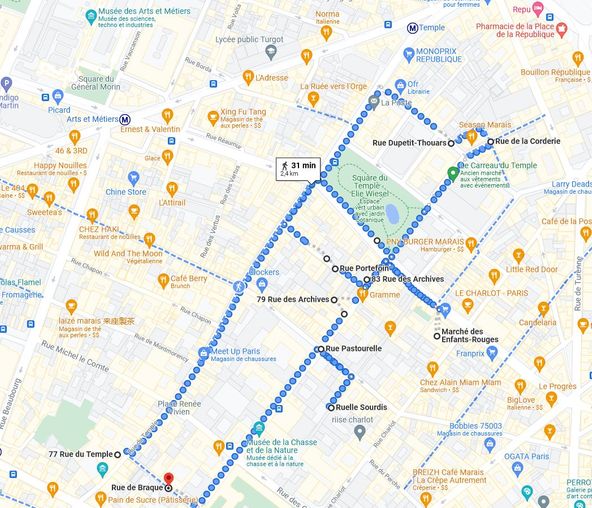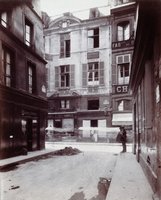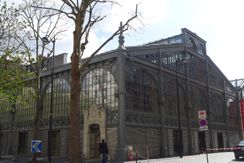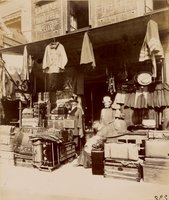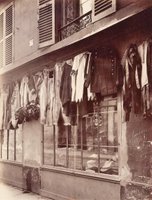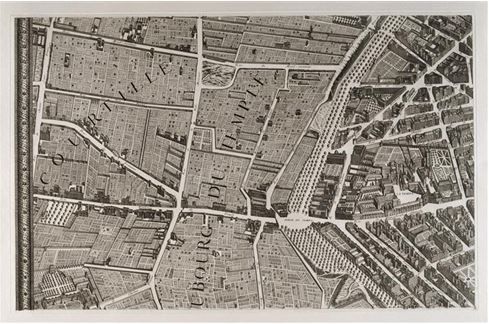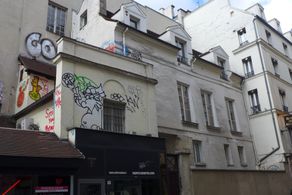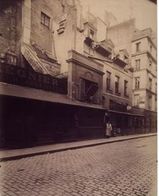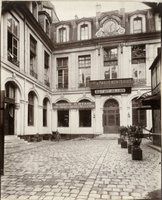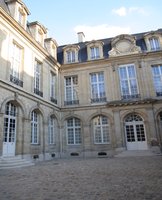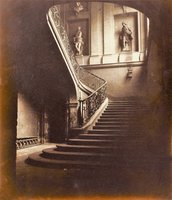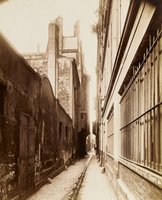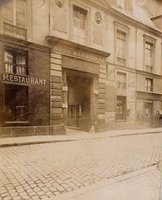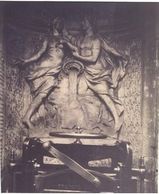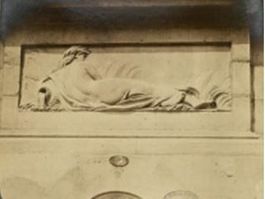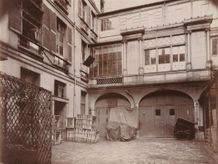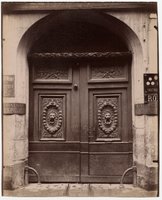Hora fugit - Un peu de Paris
Temple district
At the end of our stroll in medieval Paris, on the right bank, we have reached the Temple district.
For me, this district reminds me when I was going with my great grand-father, a watchmaker who was getting his supplies in this district dedicated in the past to the watch parts and jewellery. When the weather was nice, we were usually making a stop at the Temple public garden.
Itinerary
This stroll is mainly centred around the former Templars' estate; mainly rue du Temple, the square du Temple and the Carreau du Temple.
Rue du Temple
Rue du Temple owes its name to the vast domain of the Templars, whose power was very great at the medieval time. The Templar order, both religious and military, was founded in 1118 by nine knights, whose mission was to escort pilgrims to the Holy Land and to defend the Holy Sepulchre.
The name of Knight Templar comes from the house given to them by the King of Jerusalem, Beaudoin II, which was located next to the Temple of Solomon.
The Knights Templar, both soldiers and monks, had to vow to poverty, chastity and obedience, according to the strict rule of Saint Bernard. However, they received considerable gifts during the Crusades, which made them very rich. When their military role was over, they nevertheless kept a very high prestige with kings who granted them many privileges, including the exemption of taxes. Their financial power was so great that we read they owned up to nine thousand castles in Europe.
In Paris, they first settled near the Seine, in rue de Lobau, where they cleared some of the marsh land. Then in the second half of the 12th century, they settled in a broad area to the north. In this countryside, they built a cloister protected by walls and a large dungeon.
The Temple enclosure became a small city in the city, enjoying considerable privileges. Whoever crossed their gateway was protected for a fee paid to the Grand Master's tax collector.
In 1307, Philip The Fair, in his quest for more money, took the Templars' treasure and charged them for heresy. While the Temple was being emptied, the Inquisition tortured the Templars accusing them of their relationship with the Devil. After more than six years in prison, Jacques de Molay was led to a pyre at the end of the Île aux Juifs, today's Place Dauphine and the Vert-Galant. It is where he pronounced his legendary curse on the kings of France for thirteen generations.
The Templar possessions were handed over to the Hospital of Saint John of Jerusalem (which later became the Order of Malta) until the French Revolution.
By a curious turn of history, the Jacques de Molay curse would seem to have been extended to the dark days of the Revolution, with the imprisonment of Louis XVI in the Templars dungeon. At this time, only the palace of the Grand Prior and the large dungeon remained. The dungeon of the Temple stood where the rue Eugène-Spuller is now, between the square du Temple and the Town Hall of the 3rd arrondissement. Louis XVI was kept there until the time of his trial and execution on 21 January 1793 at Place de la Concorde. Marie-Antoinette was moved to the Conciergerie on 2 August 1793 and executed on 16 October 1793.
“She was awakened if indeed she slept. She embraced her daughter and her sister-in-law - her son had been taken from her a month before - and then she passed down the stairs of the Tower and out into the stifling, oppressive night. Surrounded by commissioners and soldiers she crossed the silent garden of the Temple; not, we may well believe, without turning, as Louis XVI had turned on the 21stJanuary, to look her last at the Tower that loomed, huge and sinister, in the darkness. A cab awaited her at the steps of the palace; the great gate opened to let her pass: She and her guard briskly crossed the sleeping town. ”“
The last days of Marie-Antoinette– G. Lenôtre (translated by Mrs.Rodolph Stawell)
Officially, the dauphin Louis XVII, separated from his mother on 3 July 1793, died there on 8 June 1795 at the age of 10, totally isolated and deprived of care. However, the official thesis has never been proven and the enigma of the Temple remains unsolved.
This sinister tower, which remained a state prison during the Revolution, was demolished upon Napoleon's request in 1808.
With this house photographed by Atget, located at 77, rue du Temple, we are still in the middle of the terrible period that was the Revolution. A plaque on its façade indicates to the curious passers-by that it was inhabited in 1791 by Jean-Baptiste Bouchotte, 1754 - 1840, Minister of War under the Convention.
Well, who was Bouchotte ? I have found little description about him; one written by the French historian G. Lenôtre in his book about Charette, a man who played a key role during the war in Vendée during the French Revolution.
“… Not a bad man, hard worker, very moral, motivated by good intentions, this Chief officer of the Army has a gift for promoting those incompetent and for preferring the naughty ones. He was the patron of the incompetence. As a Republican at its core, he thought his first duty was to democratize the Army and the offices of his Department; ”
Old house
77, rue du Temple
Atget
(Musée Carnavalet)
This rather negative description is echoed in Victor Hugo's Ninety-Three about Cimourdain, the envoy of the Committee of Public Safety:"
"No one today knows his name. History has many of these great Unknown.”
We now walk along the Square du Temple and turn right onto Rue du Petit Thouars.
Rue Dupetit-Thouars
We are in the neighbourhood of the Carreau du Temple, once dedicated to the second-hand clothes trade since the end of the 18th century. The market for old linen, clothes and rags was held in a vast hall with more than 1800 shops spread over four pavilions crossed by four streets named after sailors: Cafarelli, Dupetit-Thouars, Dupuis and Perrée.
Some of these pavilions had evocative nicknames: the Pou-Volant (the Flying louse) specialised in scrap metal and second-hand goods, the Forêt-Noire (Black Forrest) in shoes. The area where the vendors placed their goods on the ground, on the "carreau"(the tile), was called the Carreau du Temple. This name remained when the buildings were demolished in 1863 to make way for a vast market, known as the Carreau du Temple, made up of metal structure pavilions, where the first Paris Fair was held in 1904. Damaged over time, the Carreau du Temple almost disappeared before it was renovated in the early 2000s. The two saved pavilions are now dedicated to sport and culture. In the neighbourhood, the old clothes shops have been replaced by galleries, fashion shops, restaurants and trendy bars...
16, rue Dupetit-Thouars
1910/ 1912 Atget
(BNF)
Rue de la Corderie
On the left, the rue de la Corderie is located on the site of one of the walls that protected the Templars' vast wealth. This wall was defended by two dungeons, the Temple dungeon where Louis XVI and his family were later imprisoned, and the so-called Caesar tower. In addition to its wealth, the Order also protected some of the royal treasures and acted as a bank.
The Templars also enjoyed two important privileges: the right of shelter and the right of franchise. Anybody who found refuge within their walls was not subject to the law, except for blood crimes; many craftsmen were able to practice their trades and businesses without being controlled or having to pay taxes to the guilds.
The street was built in 1809 when the Halle au Vieux Linge was created.
Today, nothing is left of the thrift shops and dealers in used military uniforms.
Rue de la Corderie
Atget
(BNF)
Let's go back to the Carreau du Temple and take rue Eugène Spuller which leads us back to the Square du Temple. When we arrive in rue des Archives, we take rue Portefoin on the right.
Rue Portefoin
Though there were once fields around the Temple, the name of the street - Portefoin (which would mean hay-rack) has no relation to the countryside. It is just a deformation of the original name Rue Porte-Fin, named after a landowner who lived there.
14, rue Portefoin
1901/1902
Atget
(BNF)
Beside the Hôtel de Breteuil, at 14, with a beautiful gate, there was once the Hôtel de Turgot, demolished in 1894. I am mentioning Turgot, Provost of the merchants of Paris, because he was passionate about cartography. He asked Louis Bretez to draw a map of Paris which was published in 1739. Turgot's map is valuable for those who are interested in the old Paris. This map is not easy to consult as it is extremely large, with twenty different sections. In addition, in order to understand it, it is necessary to turn it 125° clockwise because it uses the Seine as its vertical axis.
Below is the map that shows the Templar district as it looked before its demolition:
- On the left is the Courtille, now part of the Belleville neighbourhood, which was a country site famous for its guinguettes.
- In the centre, the Temple Faubourg, once mostly covered in fields and bordered by the Mall where was the Charles V wall and the Temple Gate, which became the Place de la République.
See below, on the right-hand side of the map, this is the Temple as it was in 1739, of which nothing remains today except the tower located between the rue de Charlot and the rue de Picardie ( you can see the inner part of the tower inside the restaurant at 32, rue de Picardie).
At the top right there is the dungeon, destroyed in 1811
At the bottom right, there is the palace of the Grand Prieur, destroyed in 1853,
the church demolished during the Revolution
and the gateway to the enclosure which is now 158 bis rue du Temple.
Hôpital des Enfants-Rouges
We are now leaving the area where was the Temple enclosure itself. Nevertheless, we are still in a district created by the Templars between their enclosure and the walls of Philippe Auguste.
At 83 rue des Archives, the building that is covered with graffiti was built in the 17th century on a property once part of the Hôpital des Enfants Rouges. This hospital was founded by King François I and his sister Marguerite de Navarre in 1534 as a home for orphans, the Enfants-Dieu, dressed in red clothes, for which they were called Enfants-Rouges.
Old house
83, rue des Archives
1901 Atget
(Musée Carnavalet)
In the nearby Rue de Bretagne there is the small covered market of the Enfants-Rouges (end of the stroll in Arts et Métiers neighborhood). This market, created in 1615, was to supply the Temple neighbourhood and sell "poultry, game, butcher's meat and all sorts of food products". This market was also meant to supply the new district that was to celebrate the provinces of France. After the creation of the Place Royale, today's Place des Vosges, Henri IV also wished to build the Place de France, from which streets would radiate. The names of the streets were to celebrate the provinces and the major cities of France. However, the assassination of Henri IV in 1610 put an end to the project and the square was never built. However, the fan-shaped layout of the project can be found between the streets de Normandie, Bretagne and Poitou and Vieille du Temple. The streets of Picardie, Beauce, Saintonge and Perche also reflect this project.
Hôtel de Tallard - rue des Archives
This beautiful mansion was owned by the Count of Tallard, Marshal of France who was Minister of State in 1726.
Piganiol de la Force greatly admired the hotel and its elegant staircase, which he said was one of the most beautiful in Paris.
In the 19th century, the building was used by commercial activities and suffered significant deterioration. This can be seen in Atget's photo. Since its major renovation in 1981, it has recovered all its elegance...
Hôtel du maréchal de Tallard
Yard
78, rue des Archives
1898 - Atget
(BNF)
Hôtel du maréchal de Tallard
Staircase
78, rue des Archives
1898 - Atget
(BNF)
Ruelle Sourdis
Proceed along rue des Archives until you reach rue Pastourelle on the right and the curious Sourdis alley. Between Atget's photo taken in 1898 with a stunning perspective and today, nothing has changed: the central gutter, the old cobbles, stone posts and the overhanging turrets that look like they meet and form a bridge, everything has remained.
Let's go back to Rue des Archives.
Ruelle Sourdis
Atget
(Musée Carnavalet)
Rue des Archives
The odd numbered side of the rue des Archives has lost many of its old houses; in particular, between 61 and 67, three old mansions were demolished and replaced by the Central Telephone building built in 1934.
Its entrance, which can be associated with the style of Art Nouveau by the use of plant patterns for the gate and the flexible movement of the two sculptures of women, was designed by the French sculptor Jean Boucher.
61, rue des Archives
1908 - Atget
(Musée Carnavalet)
72, rue des Archives
Vers 1907 - Atget
(BNF)
If the houses on the even-numbered side were not demolished, they also may have been altered; for example, the Hôtel de Villeflix, Head of Royal Treasury, was greatly modified in especially losing its garden, which had previously been decorated with a fountain. This 18th century fountain shows a man and a woman around a jar pouring water; it is not intended to represent the king's expenditures but rather an allegory for water which is frequently found like the Haudriettes fountain. Today, the fountain no longer in a greenery place is hidden inside a small building replacing the garden.
Fontaine des Haudriettes
This 18th century fountain is an other allegory for water, representing a water nymph lying against jar of water.
In Atget's time, the fountain was standing against the houses standing at the corner of rue des Archives and rue des Haudriettes. In 1933, the houses were replaced by new buildings and the fountain moved in the middle of the street.
Fontaine des Haudriettes
1898 - Atget
(Musée Carnavalet)
Fontaine des Haudriettes
1898 Atget
Rue de Braque
Rue de Braque on our right is where we end our stroll.
At n7, the petit hôtel de Mesmes was beautifully restored. The former wall has been replaced by a grid letting a nice view over the beautiful building and courtyard.
7, rue de Braque
1903 - Atget
(Musée Carnavalet)
At 8bis rue de Braque – Hôtel de Chaulnes : you cannot miss its nice door, with carved lion heads.
Gate
8 rue de Braque
1901 - Atget
(BNF)
The stroll can stop here or can be extended with the stroll on rue des Rosiers. To do this, return to rue des Archives and turn left into rue des Francs-Bourgeois, until you reach rue Vieille du Temple.
Texte / Photos : Martine Combes
Contact / newsletter:
